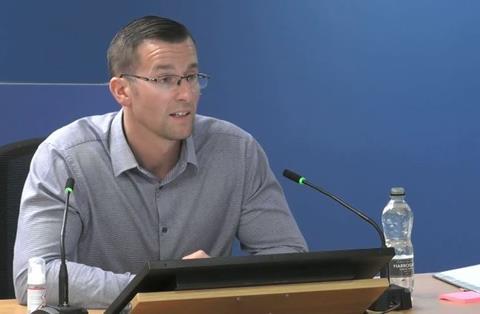Cladding firm specialist says combustibility of Reynobond PE 55 panels was ÔÇśnot something he ever thought aboutÔÇÖ
Harley FacadesÔÇÖ design manager at the time of the Grenfell Tower refurbishment expected the ACM panels earmarked for the high-rise block to melt ÔÇô rather than burn ÔÇô in the event of a fire, the inquiry into 2017ÔÇÖs disaster has heard.
Daniel Anketell-Jones was answering questions about an email exchange between members of the project team for the tower-block refurbishment in which he said it was ÔÇťridiculousÔÇŁ to include 120-minute fire-stopping capacity in the new building envelope.

The March 2015 mail concluded: ÔÇťThere is no point in ÔÇśfire stoppingÔÇÖ, as we all know; the ACM will be gone rather quickly in a fire!ÔÇŁ
In all, 72 lives were lost in the blaze that engulfed Grenfell Tower in the early hours of 14 June 2017.
The first-phase report of the Grenfell Tower Inquiry has established that the polyethylene-core ACM cladding system delivered by Harley for main contractor Rydon was the principal cause of the rapid spread of fire.
Inquiry barrister Kate Grange QC asked Anketell-Jones what he meant by ÔÇťridiculousÔÇŁ in his email, which was addressed to Harley director Ray Bailey.
He replied: ÔÇťFrom my training with structural design, I knew that aluminium facades were unable to resist a fire for very long at all and would just melt and fall off the building. So putting in a two-hour fire break on that kind of fa├žade was a waste of time.ÔÇŁ
Asked how he obtained the knowledge of how the ACM ÔÇô short for aluminium composite material cladding ÔÇô would perform in a fire, Anketell-Jones said it was based on his knowledge of aluminium as a material used in the construction industry.
He said he had not been thinking about the polyethylene core of the ACM when he had made his comment.
Anketell-Jones denied that he had obtained his insights on cladding performance at a Centre for Window and Cladding Technology members event that he attended in October 2014.
TuesdayÔÇÖs inquiry session heard that Anketell-Jones had been present at the event, at which BRE expert Sarah Colwell gave a presentation on fire testing for facades. But Anketell-Jones said he had no memory of it.
Grange said the session had looked at cladding-related high-rise fires in France, Russia and Dubai; ÔÇťmechanisms of external fire spreadÔÇŁ; and interpreting data. She showed Anketell-Jones a selection of slides from the presentation. He said they did not jog his memory.
ÔÇťI was focused on structural design at that point, thatÔÇÖs where the focus of my CPD and continued learning was,ÔÇŁ he said.
Anketell-Jones subsequently added: ÔÇťI think I might have been there and not concentrating because it wasnÔÇÖt what I was trained in and not part of my remit.ÔÇŁ
Anketell-Jones left Harley in 2016 and subsequently completed an MSc in fa├žade engineering at the University of Bath.
NobodyÔÇÖs job to ÔÇśthink about fireÔÇÖ for company
On Wednesday, Anketell-Jones was asked whose job it was at Harley to ÔÇťthink about fireÔÇŁ at the time of the Grenfell project.
ÔÇťThere was nobody assigned across the whole company to do that role,ÔÇŁ he said. ÔÇťEach individual person would look after that responsibility on their own project.ÔÇŁ
Anketell-Jones said the responsibility for Grenfell Tower would have fallen to freelance designer Kevin Lamb and project manager Ben Bailey, son of company director Ray Bailey.
Grange asked Anketell-Jones whether he ever had any discussions about the risk of horizontal or vertical fire spread from the decorative ACM crown installed on the top of Grenfell Tower as part of the refurbishment.
ÔÇťNo,ÔÇŁ he said. ÔÇťI donÔÇÖt think anyone was aware that any of the products were in the slightest bit combustible so I donÔÇÖt think it would have been something anyone considered throughout the design process.ÔÇŁ
The Grenfell Tower InquiryÔÇÖs phase one report found that once fire had spread up the east side of the building in the early hours of 14 June 2017, the crown had been ÔÇťprimarily responsibleÔÇŁ for the spread of fire across the whole building.
At the end of his evidence Anketell-Jones was asked for his personal observations on the failings that led to the Grenfell Tower fire, and what he could have done differently with hindsight.
ÔÇťAt that point I didnÔÇÖt have the education or the knowledge to have picked up on any signs that things were missing,ÔÇŁ he said.
ÔÇťSo I donÔÇÖt think I could have done anything differently without the education that I have now.ÔÇŁ
The inquiry continues.




























No comments yet